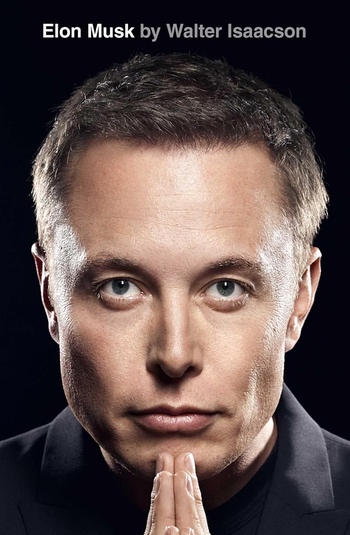Review: Elon Muskby Jeff Foust
|
| “Once he heard I’d shorted the [Tesla] stock, he was super mean to me, but he’s super mean to so many people, so you can’t take it too personally,” Gates said of Musk. |
The book follows a standard chronological approach, tracing Musk’s life from his family background and upbringing in South Africa to coming to Canada and the US for college, then starting the series of companies that would define his life and also alter society. Isaacson jumps back and forth for much of the book between SpaceX and Tesla, with diversions to ventures like The Boring Company and Neuralink; later chapters delve into Musk’s acquisition and reshaping of Twitter/X. Much of this comes from interviews with friends, family, and current and former coworkers. Later in the book Isaacson emerges in the first person as he follows Musk around, including at Starbase during the leadup to the first Starship launch in April, which concludes the book.
Isaacson focuses much of his attention on trying to figure out Musk’s personality: “Could he have been more chill and still be the one launching us towards Mars and an electric-vehicle future?” His book is an argument that he could not; that Musk’s focus, snap decision-making, and sometimes brusqueness are all essential to his success, factors that Musk himself, and some who know him well, attribute to Asperger’s Syndrome. “Elon is not an ass, and yet sometimes he will say things that are very assholey,” said Gwynne Shotwell, president and chief operating officer of SpaceX, who has worked with Musk for more than two decades.
Or, as Bill Gates put it, recounting a meeting with Musk to discuss philanthropy only to have Musk criticize him for shorting Tesla stock: “Once he heard I’d shorted the stock, he was super mean to me, but he’s super mean to so many people, so you can’t take it too personally.”
Unfortunately, for all the access Isaacson had for the book, including with Musk and his friends and family, the book is riddled with errors. Some are minor, like incorrect dates: a photo with Musk in a Tesla conference room with a SpaceX launch playing on a screen is dated 2008, but the launch shows a Falcon 9, which made its debut in 2010. (A closer inspection of the image suggests the launch was CRS-14, in 2018.) Isaacson writes that “in 2014, SpaceX built a rudimentary launchpad” at Boca Chica, Texas; all SpaceX did in 2014, and the next few years, was moving dirt around there. He also writes that Musk has been “warmly embraced” by the Pentagon “because SpaceX was the only American entity capable of sending major military satellites and crews into orbit.” That is no doubt a surprise to both United Launch Alliance, which continues to launch major military satellites, and the Pentagon, which has no crews in orbit. And those are just a few examples of varying degrees of severity.
Perhaps the biggest concern is the passage about denying Ukraine’s military access to Starlink as it sent drones to attack Russian warships at docks in Crimea. In an op-ed published in the Washington Post based on his book, Isaacson wrote, “What the Ukrainians did not know was that Musk decided not to enable Starlink coverage of the Crimean coast.” He later tweeted (er, posted) to “clarify” on that passage, “the Ukrainians THOUGHT coverage was enabled all the way to Crimea, but it was not.” In the book itself, Isaacson wrote that Musk “reaffirmed a secret policy” to disable Starlink coverage within 100 kilometers of the Crimean coast. Clarified? Maybe not.
| The first Starship launch was “a fitting metaphor for his compulsion to aim high, act impulsively, take wild risks, and accomplish amazing things—but also to blow things up and leave smoldering debris in his wake while cackling maniacally.” |
There are some interesting passages in the book about SpaceX not reported widely elsewhere. Hans Koenigsmann, who had been at SpaceX since nearly the company’s beginning, was forced out of the company, rather than voluntarily retired, when he wrote in a report that SpaceX was to blame for conducting a Starship low-altitude test flight without FAA approval because of dissenting views on how weather conditions affected safety. Musk “didn’t see it that way, and things got touchy, very touchy,” Koenigsmann recalled, leading him to be eased out.
Musk also was at one point (not specified by Isaacson in the book) so excited about the prospects of Starship that he announced to SpaceX executives in a meeting that he was cancelling the Falcon Heavy. Those in the meeting alterted Shotwell, who rushed into the meeting to explain that vehicle was still needed for military missions. “Once I gave Elon the context, he agreed we couldn’t do what he wanted,” she said.
What does Isaacson think of Musk? “The explosion of Starship was emblematic of Musk,” he writes at the end of the book after a recap of that April test flight, “a fitting metaphor for his compulsion to aim high, act impulsively, take wild risks, and accomplish amazing things—but also to blow things up and leave smoldering debris in his wake while cackling maniacally.” (Isaacson gets a little carried away with his metaphorical assessment later in that passage, referring to the “Karman line of craziness” among other things.) That message comes across plainly in his book, but future historians would be careful to doublecheck his statements.
Note: we are using a new commenting system, which may require you to create a new account.
